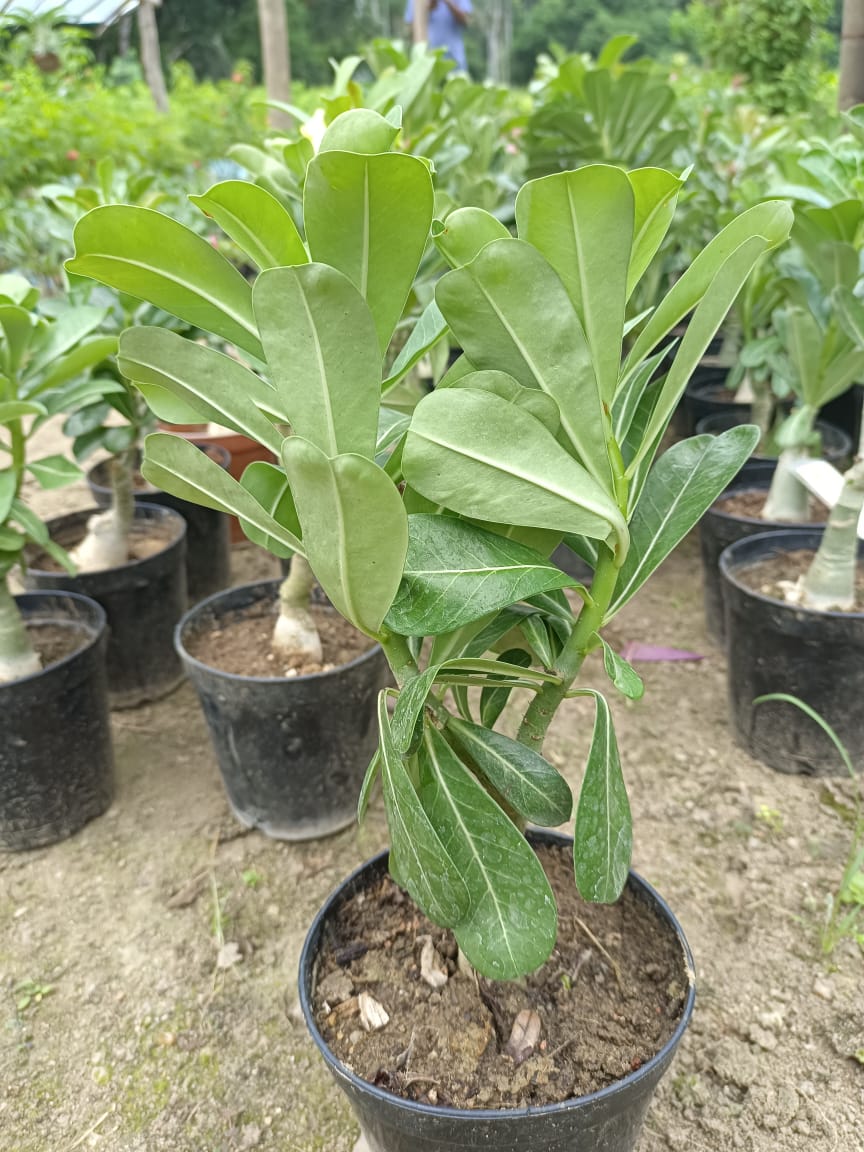Plantparadise
Adenium Red Yellow Colour Plant (Grafted)
Adenium Red Yellow Colour Plant (Grafted)
Couldn't load pickup availability
Description:
The desert rose (Adenium obesum) is a slow-growing plant, only growing about 12 inches per year. Desert rose is often used as a bonsai plant thanks to its thick succulent trunk, thin and delicate leaves, and luscious, deep pink trumpeting flowers. It is native to Africa, the Middle East, and Madagascar.
The desert rose plant is the only Adenium extensively hybridized to obtain different flower colors. Desert rose is an indoor or outdoor plant depending on your location. In many tropical and warmer climates (USDA zones 11 and 12), it's a widely-used ornamental outdoor plant, and in cooler zones, it is grown indoors. It's best planted in the spring, and it will die if exposed to frost and freezing temperatures. A member of the dogbane family, the sap of the desert rose plant is toxic to people
|
Common name |
Desert rose, Sabi star, mock azalea, impala lily |
|
Botanical name |
Adenium obesum |
|
Family |
Apocynaceae |
|
Plant type |
Succulent |
|
Mature size |
3–9 ft. tall, 3–5 ft. wide |
|
Sun Exposure |
Full |
|
Soil type |
Sandy, well-drained |
|
Soil pH |
Neutral to acidic |
|
Bloom time |
Summer |
|
Flower color |
Pink, red, rose |
|
Hardiness zones |
11-12 (USDA) |
|
Native area |
Tropical Africa, Arabian peninsula |
|
Toxicity |
Toxic to humans and pets |
Desert Rose Care
It's simple to take care of a desert rose plant, but it does take some finesse. Similar to other succulent plants, it needs careful water management and lots of sunlight.
The plant also prefers consistently warm temperatures, which is why it is grown as an indoor plant in many parts of the United States (except for USDA zones 11 and 12). The plant typically blooms during the summer months, erupting with vibrant pink, rose, or red flowers and bright green leaves. When it goes dormant for the winter season, it drops its flowers and foliage.
Light
The desert rose thrives in a full sun environment. Choose a spot in your home so that the plant receives ample light throughout the day, like a southern-facing bright windowsill or sunroom. If you live in an area where it can be grown successfully outdoors, the best place to plant the desert rose is in a spot that is not shaded by taller plants but has some protection from high-noon sun, which can scorch the plant's leaves.
Soil
As its name implies, the desert rose plant is acclimated to naturally dry, desert-like conditions, meaning well-draining sandy or gravelly cactus soil. The soil should have a neutral to acidic pH, ideally hovering right around 6.0.
Water
The desert rose plant has varying water requirements depending on the time of year and temperature. During its growing season (late spring and summer), keep its soil moist but never saturated. Check on the soil periodically and allow it to dry out completely before watering. Also, plant your desert rose in a container that has ample drainage holes. The desert rose can be susceptible to rot if it becomes too moist (a clay or terra cotta pot can also help with wicking away excess moisture).
In the fall and winter months (when the plant typically goes dormant in the wild); drastically reduce moisture, watering only minimally once a month or so. If you're curious if your plant is receiving enough water during its growing season, you can look at its trunk for the answer. A swollen, thick trunk (in proportion to the size of your plant) is a great indication that your plant is well-hydrated.
Temperature and Humidity
Keep your plant in warm temperatures at all times—it will die quickly if exposed to prolonged temperatures cooler than 50 degrees Fahrenheit. It thrives best at temperatures between 65 and 90 degrees Fahrenheit. If you've planted your desert rose outdoors, it will not likely survive any prolonged frost. Humidity is not important to the desert rose because it is accustomed to a dry, hot climate.
Fertilizer
For an added dose of nutrients (and potentially more flowers), you can feed your desert rose with liquid fertilizer (diluted by half) once a month during its active growth period. Do not fertilize the plant during its dormant period.
Types of Desert Rose
There are many species of Adenium. However, the most common and easiest to find is Adenium obesum. Some other subspecies include:
- Adenium obesum subsp. oleifolium: Native to South Africa and Botswana, this species grows to 16 inches tall with a large tuberous stem, narrow olive green blade-like leaves, and salmon, pink, or pale pink with red tubular flowers.
- Adenium obesum subsp. socotranum: Native to Socotra, an Indian Ocean island between Somalia and Yemen, this is the largest of the species, rising to 15 feet tall with an 8-foot diameter trunk. Pink flowers are up to 5 inches in diameter and appear in spring while the plant is leafless.
- Adenium obesum subsp. somalense: Native to Eastern Africa this species has narrow blade-like leaves and twisting branches. It matures at 16 feet tall with a swollen and often twisted trunk. Trumpet-shaped flowers are pink, white, or crimson red,
- Adenium obesum subsp. swazicum: Also known by its common name, summer impala lily. This is a dwarf species that usually doesn't get larger than 2 feet tall; native to Swaziland and South Africa. Showy flowers are pink to deep reddish-pink.
Pruning
Before pruning your desert rose plant, use rubbing alcohol or a bleach solution to sterilize your pruning tools; re-sterilize as you move from one plant to the next. Remove cold-damaged growth as soon as new growth emerges. Trim long, lanky stems to balance the stem growth symmetrically. Remove branches that rub or cross other branches, cutting just above a leaf node or where the stem joins with another stem.
Propagating a Desert Rose
Desert rose can be grown from branch cuttings and seeds. If you grow the plant from a branch cutting, the next plant might not have a characteristic bulbous trunk that it would if you propagate from seed. Here's how to propagate from a stem cutting:
- Before you get started, have these items on hand: garden gloves, sterilized pruners, rooting hormone, a clean pot, and a well-draining potting mix.
- Put on garden gloves to avoid the toxic sap of this plant touching your skin. Using your pruning snips, take a 5- to 6-inch cutting from the tip of a branch.
- Allow the cutting to dry out for a day or two.
- Wet the cut end and dip it in rooting hormone.
- Plant the cut end into a well-draining growing medium like perlite or sand mixed with potting soil.
- Water the cutting daily; however, make sure the water drains out of the soil. The cutting should take root in about two to six weeks.
- After six weeks, you should notice new growth, or if you try to tug at the stem gently, it should feel rooted in place.
t.
Materials
Materials
Shipping & Returns
Shipping & Returns
Dimensions
Dimensions
Care Instructions
Care Instructions




